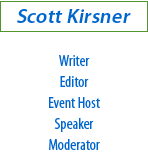

13 Guidelines for Great Panel Discussions
Advice for Event Organizers and Moderators
I've had the chance to moderate dozens of panel discussions, at places as diverse as the Harvard Business School, the South by Southwest Film Festival, Las Vegas' humongous Consumer Electronics Show, and a convention of agricultural marketers in St. Louis. I've also planned conferences, assembled panels, and recruited other moderators. This article is a compilation of some of the things I've learned.
While it's of course important for every panel to have a tight focus or value proposition (what is the audience going to get out of it?), and for the moderator to have a sense of how to structure his questions and juggle the different points of view, I'm going to leave those issues for another day. Instead, I want to talk about how a panel's success can hinge upon some subtle, under-appreciated factors -- all of which need to be considered well before the day of the event arrives. Some of the factors may seem insignificant, but I've found that each one has a big impact on how much your audience will get out of your panel.
![]()
1. Length and panel size.
The ideal length for a panel discussion is 45 minutes to one hour. The ideal number of participants is 4-5, plus moderator. I tend to book five guests for many panels, on the assumption that one of them sometimes drops out at the last minute, leaving me with four. Panels with five people can work, but once you get to six, everyone on the panel starts to get anxious about getting enough airtime.
| Some photographic examples:
Here's the typical panel set-up, best avoided: The moderator is at the podium, and panelists are hidden behind a red-draped table. |
2. Choosing a moderator.
Every panel needs a strong moderator, and the role of the moderator is very different from the role of a panelist. I don't recommend having one of your panelists try to fill both roles. It's like trying to conduct an orchestra while playing a solo.
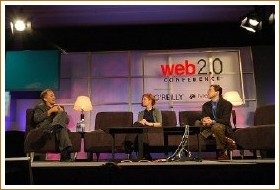 I was at this conference in 2005, and the production values were great. Note the two lamps on side tables, the two small coffee tables in front of the panelists, and the bright lights above the stage. The only problem here was that they left extra chairs onstage when they weren't needed, which resulted in big gaps between the speakers. |
There is a very delicate balance between a moderator who talks too much and one who doesn't talk enough. The moderator who talks too much typically believes that she should contribute as much to the panel as the panelists, and is as much of an expert as they are, and wants to convey that to the audience. The moderator who doesn't talk enough lets the inmates run the asylum: some panelists will go on long jags, discoursing on topics that are not related to the panel at all.
Journalists, analysts, industry "gurus," and consultants can all make good moderators, since they're accustomed to asking probing questions. (I tend to think that people without something to sell to your audience work best as moderators, which sometimes excludes consultants and industry gurus, who may be inclined to shill for their services.)
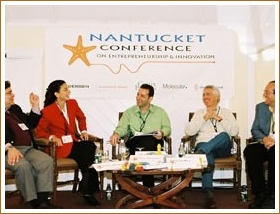 Putting the moderator (in this photo, me) in the middle sends the subtle message that he is going to guide the conversation (and also makes it easier for him to redirect panelists if they drift off-topic). Everyone has a comfy chair, and a lapel microphone. One problem: the coffee table is cluttered with printed name-tents, so it's hard to tell which speaker is which. But a few of the items on the table are items that Marina Hatsopoulos (the speaker in the red jacket) brought for show-and-tell - far better than slides. |
I often tell moderators that they are "all-powerful" - but I expect them to know that that doesn't mean they're the star of the panel. I often tell speakers that the moderator will "guide the conversation," so that they know what to expect, and aren't surprised if the moderator reins them in or redirects them.
3. Panelist guidelines and advance preparation.
I think it's a good idea to communicate with panelists at least twice before the event -- and yes, it is possible to over-communicate, annoying your panelists and causing them to pay less attention to the materials you send them.
Once a panelist has signed on, I send a confirmation via e-mail thanking them for agreeing to be part of the event. Contained in this e-mail are the date/time/location of the event; anything the speakers need to do in advance of the event (such as send in a short bio for your program book or reserve a hotel room or indicate their meal preferences); and a mention that they'll be hearing more from you or the moderator about the specifics of their session in advance of the event.
The second communication, which can come from the event organizer or the moderator, should again list the date, time, and place. It's a good idea to send this at least two weeks before the event itself. The focus of this communication is to let the panelists know who'll be moderating, and get into more detail about the topics/themes of the session, and what you hope to achieve.
Explain how the session will proceed, and what each panelist should be prepared to do. (Often, I find myself saying, "Don't bring a prepared speech or a PowerPoint presentation, just your anecdotes, recent experiences, and data points about this topic.") The moderator may want to include some sample questions. You might also want to send the panelists a copy of the full agenda (or point them to it online), and the bios of their fellow panelists. Another good idea is to send them a cell phone number for the person who'll be coordinating event, in case a panelist is having trouble finding (or getting to) the venue on the day of their panel.
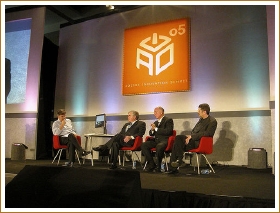 Panelists are more comfortable when they have a sense of what topics you'll be discussing during the session, and a few of the questions you may ask. But it is possible for panelists and moderators to overprepare, sapping the spontaneity. |
I don't tend to organize conference calls among panelists before panel discussions, as I've found this can be more trouble than it is worth. Scheduling is difficult, and if even one panelist misses the call, someone needs to fill him in on what happened. I think it's sufficient to get the panelists together in the hallway fifteen minutes before a session, or have them sit together at breakfast or lunch. Spontaneity is preferable to having all of your panelists preface their statements by saying, "As we discussed on the conference call..."
But once your panelists are on-site, make sure they get connected to their fellow panelists and the moderator as quickly as possible.
A CEO once told me that he'd been on a live TV show where the only instruction he got beforehand was this: "No dead air." I think that's a good instruction to give panelists, too. I also usually tell them that I'm not necessarily going to go straight down the line and have each of them answer every question. Instead, I ask them to jump in whenever they have something to say.
I also frequently mention that it's not a bad idea to accentuate conflicts and differences of opinion (not in an aggressive way, of course), rather than highlighting areas where the panelists agree ("I agree with what the other four panelists said.") That makes for an action-packed and enlightening panel.
4. Slides.
Since a panel discussion is usually part of a larger agenda that includes plenty of slide presentations by keynote speakers and others, I usually ask panelists not to bring slides to show as part of the panel. Audience members will enjoy hearing the panelists' perspectives sans slides, and seeing the interaction between the panelists. No one has ever left a conference or seminar saying, "I just wish there was more PowerPoint." That said, there are some topics that can benefit from slides.
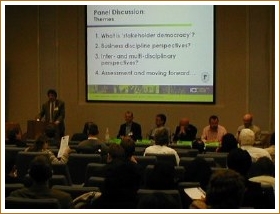 PowerPoint poisoning: If at all possible, ask your panelists to leave the slides at home. |
You should avoid having your speakers connect and disconnect their own laptops to the projector during the session; either an audio-visual person should do this, or you should have all of the slides on a single laptop and someone designated (again, not a panelist) to switch from one presentation to the next.
Even better than slides is asking speakers to bring objects for "show-and-tell"; this only works in some circumstances - for instance when your panelists represent manufacturing companies, or they're doctors implanting a new kind of medical device, or they're designers. If a panelist brings a couple of cell phones that his firm helped to design, the audience can pass them around while he's talking.
5. Setting the stage.
The worst kind of set-up for a panel discussion, unfortunately, is the one you encounter most often in hotel ballrooms and convention centers. There is a long table on a raised stage, usually draped with a red tablecloth, with chairs behind it. The moderator stands at a podium apart from the speakers. There is a gap of about twenty feet between the stage and the first row of seats.
It's much better not to hide your panelists behind a table. The audience will appreciate seeing them better: body language is a very subtle thing, and it's often part of panel discussions, especially when people joke with one another or disagree about something. Give your panelists tall stools, or regular chairs, to sit on. (If you have a few side tables that can go between some of the chairs, or a low coffee table that can go in front of them, those can be handy for placing pitchers of water or notes that your speakers may carry onstage with them.)
 Nice stage set-up, with coffee tables and comfy chairs for panelists (though there may be too many of them.) But the chairs are set in a straight line, rather than a slight semi-circle, which makes it tough for a panelist on one end to make eye contact with the person on the other end. |
The moderator should sit with the panelists so that he or she can guide the conversation, not at a podium; I usually like to sit in the middle.
Your objective should be to get the first row of seats as close to the stage as possible, and to encourage people to sit in them. This raises the energy level in the room. It makes your speakers feel more accountable to the audience, and it helps your audience feel like they're part of the conversation. If you have some freebies or prizes that you can give away, the moderator or conference host shouldn't hesitate to use them to bribe people to move from the back to the front row, just as you're beginning the session.
6. Everyone needs a microphone.
It can be a clip-on lavalier mic, or a handheld, or a mic perched on an adjustable stand, but forcing everyone to share a single mic means that there will be long stretches of dead air as your panelists hand the mic back and forth.
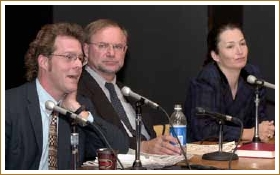 When everyone has a microphone, no one has to worry about when they'll get an opportunity to chime in. |
A second-best option to having mics for everyone is to have mics for half of your panelists - but one microphone dedicated to the moderator, who needs to control the flow of the discussion. Panelists can then share a mic with their immediate neighbor, reducing the amount of mic-passing that has to take place.
7. Lighting.
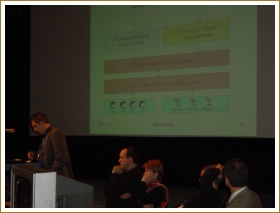 Can't you just hear the audience snoring softly? Slides force you to lower the level of light in the room, which makes it tougher to see the speaker...but easier to catch some Zs. |
8. Identifying your panelists.
You want to help your audience understand which speaker is which - even if an audience member missed the beginning of the session, when each speaker was introduced.
 Nice big name-tents in front of each speaker. And each person has his own individual table, though they look so spindly that I suspect the slightest nudge with a knee would knock one over. |
I'm not a fan of putting the speakers' names on folded name tents, since these are usually hard to read from the back of the room. But if you have a coffee table onstage, you could certainly place name tents on the front of that, or on the front edge of the stage.
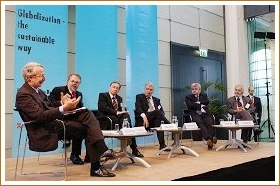 Very nice set-up. Chairs are arranged in a slight semi-circle, so the panelists can all see each other. The low tables give them a place to put a glass of water or some notes. There are paper name-tents in front of each speaker. And the lighting in the room is plenty bright. |
9. Audience interaction.
The best moderators don't wait until the Q&A period to get the audience involved. A very basic technique is starting the session by polling the audience. Where are they from, what job function are they in, what industry, what level of experience do they have with your topic? This will give the moderator and the panelists a good sense for who they're addressing, and it'll keep you from doing a pro-level panel for an entry-level audience, or vice versa.
If your panelists all agree on a question, you can ask the audience if anyone is willing to stand up and offer a dissenting view. There are zillions of other inventive ways to get the audience involved, and I guarantee it will make your panel better. You might have entrepreneurs do a one-minute explainer of their business idea, and have the panel offer feedback or ask probing questions. If your panel is about hiring, you might have an audience member participate in a mock interview. If your panel is about advertising, you could show ads produced by the panelists and ask for audience reaction to each one. You could create buzzword bingo cards for the audience, and let them check off buzzwords as you and your panelists utter them, with a prize for the winner.
Think of a great magic show, or Springsteen pulling someone up from the front row during "Dancing in the Dark." Participation just makes it better -- as long as you use your volunteers respectfully, and don't put them in positions that will embarrass them. (By the way, I've tried many digital and mobile technologies for polling the audience, and while some are OK, none is better than the old-fashioned approach: asking people to raise their hand, or stand up, or come onstage.)
10. Question and answer period.
For an hour-long panel discussion, you should allocate at least fifteen minutes at the end for questions. Twenty or thirty minutes is better, if you think the audience will have lots of questions and if the panel is more educational in nature. My belief about panels is that the moderator can easily spend the entire time asking questions that she believes the audience cares about... or she can actually let the audience ask questions that it cares about.
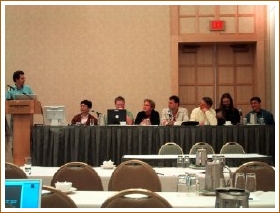 The gap kills: With no one sitting in the first two rows of the ballroom, there's a giant gulf between the panelists and the audience. The result is usually a low energy level in the room. |
The moderator might also choose to let the audience know that he or she will take questions throughout the panel discussion, if audience members raise their hands. The key with doing that is not to allow an off-topic or obscure question to derail the panel and bore the other audience members. If you get a super-detailed question that seems like it is only of interest to the questioner, the moderator can easily ask one panelists to address it, and then move on.
During the main question-and-answer period, the moderator should try to avoid calling on the same person twice until everyone has gotten a chance to ask a question. In the event that there are no questions immediately, it's good for the moderator to either have someone in the audience (perhaps one of the organizers) primed to ask a question, or for the moderator to have an extra question or two in reserve.
Not everyone on the panel needs to weigh in on every question; my goal as a moderator is usually to try to get as many audience questions into the Q&A period as possible.
11. Watching the clock.
It's the moderator's job to make sure no panelist drags on for too long, and that there's plenty of time for questions at the end. To help the moderator and panelists, you may want to have a digital countdown clock that all of the speakers can see positioned at the edge of the stage.
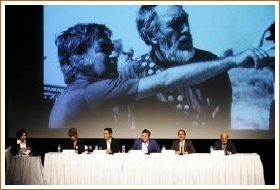 Good lighting, but the moderator looks like she is stranded on her own desert island, at left. And everyone is hidden by the draped table. |
Why is time-keeping important? You may have a panelist who has booked a flight or made an appointment assuming that her panel will be done at 1 p.m., and there's nothing worse than someone leaving the stage before the panel is over. (I've seen it happen.)
12. Thank your panelists.
 Beautiful venue, great lighting, and a nifty aqua backdrop. The room seems full, which keeps the energy level high. One way to fill up a room, which they've done here, is to set it up "classroom style," with tables in front of each row of seats, instead of "theater style" (just rows of seats.) It's also possible to do a mix of theater and classroom style, putting a few rows of theater style seating in the front, and classroom in the back for people who want a table for note-taking or using their laptop. This panel does seem to have nine people on it, though, which makes it start to look like the National Spelling Bee. |
13. The panel ain't over when it's over.
Many audience members will want a chance to chat informally with the panelists and moderator. Ask your speakers in advance to stick around at the event for at least 15 or 20 minutes after their session, so that attendees will have a chance to buttonhole them in the hallway after their session. Even better is to encourage them to stay for lunch, dinner, the cocktail hour - or whatever else you've got planned.
I'd love to hear some of your advice about running panel discussions - or your experiences putting some of these tips into action. Drop me a note. (Here's a list of some of the events I've been involved with in the past - and a few that are still ahead.)
![]()
A few panel-related links:
